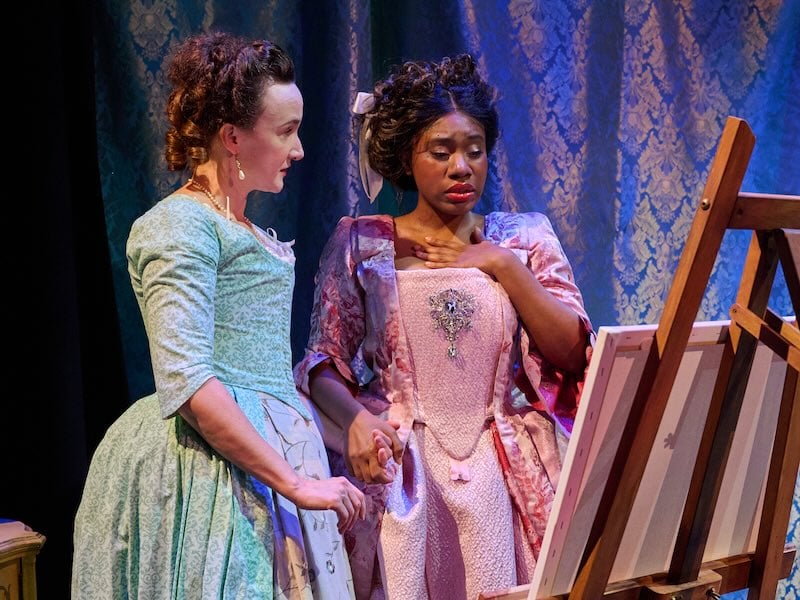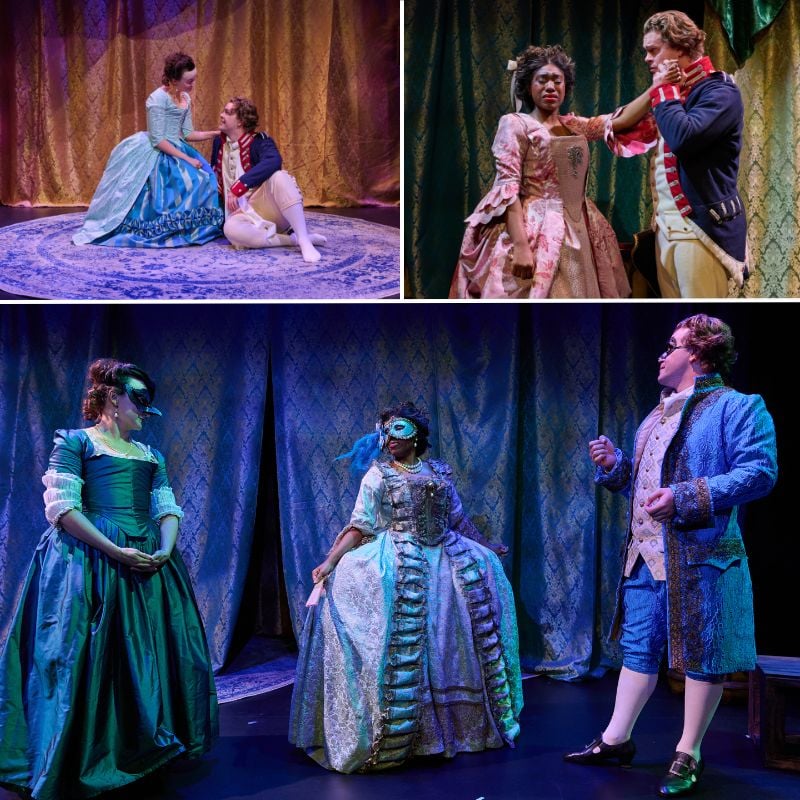Skin tone, as we all know, has been one of the great and deeply unfortunate obsessions of human history. It has also been an obsession of portraitists, who have struggled to present accurate likenesses of their sitters and often aimed to endow them with greater beauty than they really possessed. In portraiture, flesh tone can suggest race, status, and background; it can reveal the truth, or it can attempt to hide it. The idea that a great artist can capture — or conversely attempt to conceal — the essence of a person in the depiction of their skin is a central conceit of Joel Gross’s Marie Antoinette: The Color of Flesh, presented by Perisphere Theater at the Writer’s Center in Bethesda through June 21. Although ostensibly about France’s doomed queen, the play’s real focus is the relationship triangle involving the great female portraitist Élisabeth Louise Vigée Le Brun (“Elisa”), the tragic Marie Antoinette, and a fictional French count with revolutionary sympathies named Alexis de Ligne. A strong presentation by Perisphere, both onstage and behind it, suffers to an extent from weaknesses in the script, which does not fully explore the theme implied by the play’s subtitle or provide entirely satisfying motivations for its characters’ interests and attractions. That said, director Lizzi Albert’s decision to cast an African American actress (Mecca Verdell) as the doomed Marie Antoinette helps illuminate what Gross may have intended with his subtitle and serves as a reminder of the strict race and class codes that people struggled under during the ancien régime and continue to struggle against in a modern democracy.

Albert and her team tease out several motifs in the play that are especially resonant today. The count (a fine Gil Mitchell) is the conduit for a growing friendship between the queen and her portraitist, Le Brun (a radiant Laura Rocklyn). He is also a man taken with revolutionary sympathies (though the source of these feelings remains unclear), who eventually joins the American colonists in their revolt against Great Britain. He decries the growing economic inequality of pre-revolutionary France and the oppressive taxation imposed on the middle and working classes that supports life at court and wars abroad. He agitates for change but is unprepared for the extent of change that will eventually engulf his own country.
Juxtaposed with such ideas are those of the queen (a sufficiently imperious Mecca Verdell) and Le Brun (“Elisa”), who largely view the masses as “rabble.” (Elisa tells the count that, as someone who came from the working classes, she understands their true nature better than an aristocrat like him could.) However, differences of opinion about the origins of France’s woes don’t hinder the growing friendship between the queen and her portraitist or the amorous relationships between each woman and the count. We don’t get much insight into the basis of these attractions or whether de Ligne’s revolutionary interests really trouble the women, although the queen deems the American conflict “ridiculous,” and Elisa acknowledges a desire to stay out of politics and paint people in palaces. (She did so, becoming Marie Antoinette’s favorite portraitist, painting the young queen some 30 times.) Solidifying the relationship between Elisa and the queen, although not much developed, are suggestions that both (from very different classes) have suffered the domination of husbands in a patriarchal society.
The triad of actors brings out the humor in the play and nicely delineates the distinction between the formality of public life and the informality of life in the boudoir or the artist’s studio. Albert’s pacing is generally brisk, and her stage movements are well-choreographed. Often, the actors form stage pictures with their bodies that resonate with the play’s portraiture motif. Only in Act Two does the focus get a bit lost in a long confrontation scene between Elisa and the queen. A final reconciliation scene between the two, after Marie Antoinette has been imprisoned during the Reign of Terror, is poignant for what it says about Elisa’s love for a fallen friend, rather than her ambition as a painter.
While Elisa does talk about the difficulty of getting a sitter’s skin tone just right, and the queen demands that Elisa paint her as she is (“I don’t want to look like you,” she says), the theme of racial or class differences being only skin deep doesn’t feel fully developed in the script. That’s not Perisphere’s fault, but it is an opportunity lost in a play that explores history and portraiture, two ways of seeking truths about the past. It’s also worth noting that the real Elisa, like her fictional counterpart, often made her sitters look better than they really were.

Any artist would be proud of the set, costumes, and effects that Perisphere brings to this story. An array of silk-like curtains, a simple painter’s easel, and a stool or banquette make a handsome backdrop for the queen’s apartment, the artist’s studio, or the alcove of a ballroom. (The set design is Simone Schneeberg’s.) Katie McCreary’s lighting design facilitates smooth transitions between these spaces (and the emotions displayed in them) and highlights the fabric backdrop of the set. Cheryl J. Williams’ sound design carries us impressionistically into the street, the ballroom, and outside the prison with the mob. Perhaps most flattering of all are Hannah Brill’s wonderful period costumes (especially those for Marie Antoinette), which often seem to float under McCreary’s admiring lights.
In the years leading up to the French Revolution and during it, Marie Antoinette was an object of scorn for many in her adopted country, who held her culpable for the misery and injustices they suffered. In Marie Antoinette: The Color of Flesh, the tragic queen is an object of love, worthy of being painted repeatedly, even if the result is sometimes flattery. In this play’s triangle of love, friendship, and ambition set against the backdrop of a painter’s easel, it’s not exactitude that matters, but vibrancy — and Perisphere brings plenty of that.
Running Time: Approximately two hours with one intermission.
Marie Antoinette: The Color of Flesh plays through June 21, 2025, presented by Perisphere Theater performing at The Writer’s Center, 4508 Walsh St, Bethesda, MD. Purchase tickets ($35, general; $30, senior; $20, student, plus fees) online.
The program is online here.
Marie Antoinette: The Color of Flesh
Written by Joel Gross
Directed by Lizzi Albert
CAST
Marie Antoinette: Mecca Verdell
Élisabeth Louise Vigée Le Brun: Laura Rocklyn
Alexis de Ligne : Gil Mitchell
PRODUCTION
Set Design: Schneeberg
Lighting Design: Katie McCreary
Sound Design: Cheryl J. Williams
Costumes: Hannah Brill



